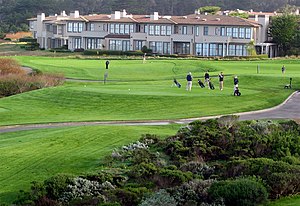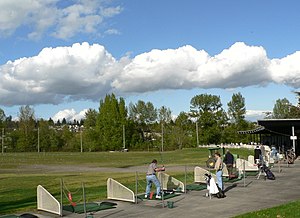Greenskeeper
This article does not cite any sources. (August 2016) |
A greenskeeper (or greenkeeper) is a person responsible for the care and upkeep of a golf course or a sport turf playing surface.




Work description and duties[]
A professional who maintains a golf course's or country club's grounds. This includes all cultural practices along with setting of pins and marking of hazards for regular club play along with tournament play. Greenskeepers work under the direction of the Golf Course Superintendent or Director of Golf Course Operations. For a greenskeeper, it is more important to have experience and capability than formal education.
Measuring green speed with a stimpmeter[]
Greenskeepers measure the "speed" of golf greens with a stimpmeter. The stimpmeter is used to compare green speed within a facility to ensure consistency. Stimpmeter readings should not be used to compare one facility with another; many factors, including design, undulation and grass type affect green speed. The tool measures how fast a green allows the golf ball to travel. A greenskeeper can increase the speed of the green by mowing the grass shorter, mowing more than once in multiple directions, or by topdressing the green with a small amount of fine sand to alter the putting surface.
Responsibility of setting the pins for play[]
Setting pins and tee markers is the one part of the job that differ from the job of other groundskeepers and horticulturists. Otherwise, most groundskeeping tasks are nearly the same.
Many people who have played golf, know that the hole and pin (flag) on a green are moved routinely. When setting or moving the pins on greens, a greenskeeper must think about these factors all together.
- The pin location will affect the golf course difficulty.
- Turf grass on the golf green wears and tears around the putting hole.
- A pin and hole cannot be legitimately placed at every place on the green.
In most cases, the greenskeeper that sets the greens pins also moves and sets the tee markers. The tee markers are the pieces stuck in the ground that mark the line from which to tee-off or strike the golf ball. If a greenskeeper moves all the tee markers to the back of the tees and then, in addition, moves all the holes and pins to the back of the green, the accumulation of total yards to cover would be drastically increased.
Almost every golf course is measured and rated according to yards/distance. Because of this, it is wise to keep the accumulative yardage for daily play close to the rating for the course. There is no total number of yards to guide greenskeepers for each day's moving of the pins. It's a judgement call, an estimation.
A course should be measured from the medal plate (furthest distance possible on each hole, minus approx 2 yards from rear of the tee to allow for backswing) of the tee to the centre of the golf green following the center of the fairways. The actual distance of the hole may be slightly longer, with a pin at the rear of the green, but golfers should check scorecards or stroke-savers to find the depth of the green to aid club selection.
If a greenskeeper sets several golf green pins back behind the center of the green, it's logical and reasonable to set some other greens pins in front of the green center, on the fairway side.
In similar fashion – not in reference to yardage – some pins should be placed on the left of the green, some on the right, and a few in the center in regards to left and right placement.
For general daily golf play, some pin placements should be easy, some medium and some hard. The closer the pin is to the fairway does not mean an easier shot, especially if there is a bunker (sand trap) immediately in front of the green. In that case, the rear of the green may be the easier pin placement even though the distance is greater.
Learning the layout of a golf course helps for setting both the pins and the tee markers. If all the tee markers and greens pins are set on the right, that will bring the trees on the right side into play. If all tee markers and greens pins are set on the left, that brings the trees on the left into play.
The trees on the left, and the trees on the right, affect different players. Some players "SLICE" the ball to the right. Some golfers "HOOK" the golf ball to the left. A slice or hook are when the ball's path curves in flight after it is hit.
Since some players may chronically hit the ball to the left or to the right, it's only fair to give a near equal advantage to every player. So a greenskeeper should bring trees into play from both the right and left sides of the tees, fairways and greens. This is controlled by the setting and position of the tee markers, golf, green holes, and pins.
As much as possible, a pin should be set in an upright or "PLUMB" position. Plumb is at 90 degrees to a level or horizontal plane. A golf green pin should not be perpendicular to the green surface because a green surface is not usually level. If the pin is set at a 90 degree angle to what we would consider a "level line", then a golfer can look down the fairway and see how drastic or how little a green surface deviates from a level surface.
Placing pins is done by "feel" and experience. Typically, a greenskeeper lets the weight of the cup cutting tool dangle so that gravity makes it vertical and plumb. Then the greenskeeper twists the handles to slice the round cutting cylinder into the green while trying to keep the tool in a vertical position. After the tool cuts in, it lifts a cylindrical core out of the new hole. This core of soil is saved to repair the old or previous hole after the cup is snagged and lifted out. Once the old hole is plugged with the soil and turf core, the greenskeeper places the cup into the new hole.
The greenskeeper then sets a round gadget called a cup-setter onto the cup and presses it down. This sets the top of the cup below the green's surface by about 1" according to golf standards. If the cup is located too high, a golf ball may roll into the hole and ride the rim of the cup, then roll back out. By setting the cup down properly, a ball should stay in the golf green hole.
Because the green wears around the hole from daily putting and play, the new greens pin location should be located at least 12' to 20' away from the previous one. The wear and tear can mean moving the greens pin daily during summer time golf play. In summer, if a pin is left in the same spot for a few days, the turf can be practically destroyed.
It is okay to place a golf hole on a slope. If a ball is putted uphill toward a golf hole and pin, if the ball stops rolling uphill before it goes in the hole, that ball should stop in place and not roll back downhill again. If the ball is hit uphill and then rolls back downhill, that slope is too steep for a golf pin placement.
Various tournaments, men's clubs and women's clubs, may have their rules, but in general, a golf green pin should not be placed closer to the golf green's edge than about 8' to 10'.
Right of way[]
Never hit a ball onto the green when a greenskeeper is there unless they clearly motion for you to do so. Generally, golfers have the right of way on a golf course, and workers will wait or yield to players. But if a greenskeeper is on the green, and the pin is out, they have the right of way.
Further reading[]
- Stimpmeter Instruction Booklet at the USGA.
- Guide to building and maintaining putting greens
- About the concept of "homeowner" greenskeepers
See also[]
- Groundskeeping#Groundskeeping equipment
- Turf management#Golf courses
References[]
- Golf people
- Groundskeepers
- Sports occupations and roles
- Horticulture
- Lawn care